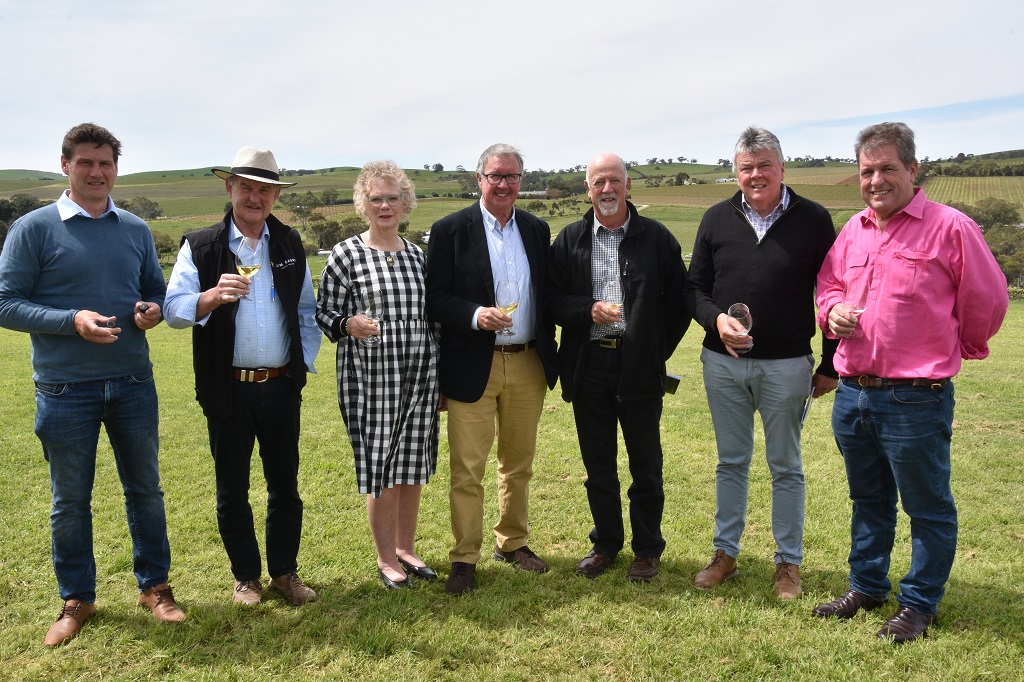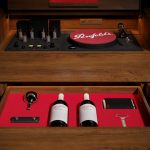Original screwcap members with Steve Baraglia, event organiser. Image courtesy Clare Valley Wine and Grape Association
An historic wine tasting, two decades in the making, took place in the Clare Valley last week. In one sense it was an examination of Clare Valley Riesling from three exceptional vintages – 2002, 2012, 2022- but in another, it was an occasion to mark the moment when Clare’s small winemaking community changed the world by bottling their 2000 vintage wines under screwcap.
Frustrated that the fallibilities inherent in cork had the greatest impact on aromatic white wines like the Riesling for which they were famous, the Clare Valley winemakers banded together to take charge of their own destinies.
Tackling misguided consumer resistance by presenting a united front, a bold cohort of fourteen producers from the winemaking community of Clare combined and commissioned the development of a new wine bottle closure to bottle their Riesling production under screwcap closure for the 2000 vintage.
In 2002, realising they had one of the all-time great Riesling vintages on their hands, this same group decided to cellar a small part of their production from that year for a tasting to be held twenty years into the future.
They hoped that this tasting would be a definitive rebuttal to one of the major misconceptions about screwcap technology prevalent at the time – that the wines wouldn’t age as they should under a screwcap.
There were major hurdles to jump relating to the technology, and massive practical problems in simply sourcing suitable bottles and caps to make it all work.
But they pushed on regardless and that decision was vindicated. Presenting those wines, alongside the 2012 and 2022 vintages, to an audience of national and international media and key trade figures, the questions of two decades ago found emphatic answers.
The wines had aged beautifully.
Most importantly they had aged consistently, each bottle of each older wine having progressed without any of the random oxidation or bacterial taint that can afflict wines bottled under cork.
Internationally renowned wine writer Stuart Piggot noted the tasting was a fantastic experience to be part of.
“At the beginning, it was a very small group, and now it is a global phenomenon with immense importance for the entire industry. Not bad for little Clare Valley,” he said.
“It’s not every day that I get to taste one wine that has been under screwcap for 20 years and never before have I tasted as many as nine wines from one region, one grape variety and one vintage that have been under screwcap for 20 years.
“Many of them showed extremely well and as a group they demolished the frequently made assertion that all wines under screwcap either don’t age or age all the same. Bullshit! A great tasting with great comments from those in attendance.
“That kind of thing doesn’t happen every day to put it mildly.”
“Our winemakers worked together, their entire focus on allowing the quality of bottled Riesling to improve, particularly with age,” Martin Ferguson AM, Chairman of the Clare Valley Grape and Wine Association said.
“More than 20 years later, we celebrate what was achieved with outstanding examples of these wines and, if history is anything to go by, we know the Clare Valley region, its people and our wine will continue to impress for many years to come.”
Many of the original winemakers who made the decision back at the start of this century where in attendance, quietly content with their decision.
“You can see in the wines today that we made the right call,” said Andrew Hardy, now of Ox Hardy wines, but then Chief Winemaker at Knappstein Wines and Chair of the Clare Valley Winemakers Association.
“But it’s not just the wines today telling us that. The market has too. Back when we made the decision as a region to go to screwcap, less than two per cent of the white wines in Australia were bottled under a screwcap.
“Now, two decades later those figures have completely flipped, and 99% of the whites produced in Australia are screwcapped.
“When you see the young wines looking just as we had seen them out of tank in the winery, when you see the older wines allowed to age gracefully without fear of a failing cork, when you look at the ubiquity of screwcapped bottles on the bottle shop shelves, you have to wonder why we didn’t do it sooner.”
Are you a Daily Wine News subscriber? If not, click here to join our mailing list. It’s free!
















